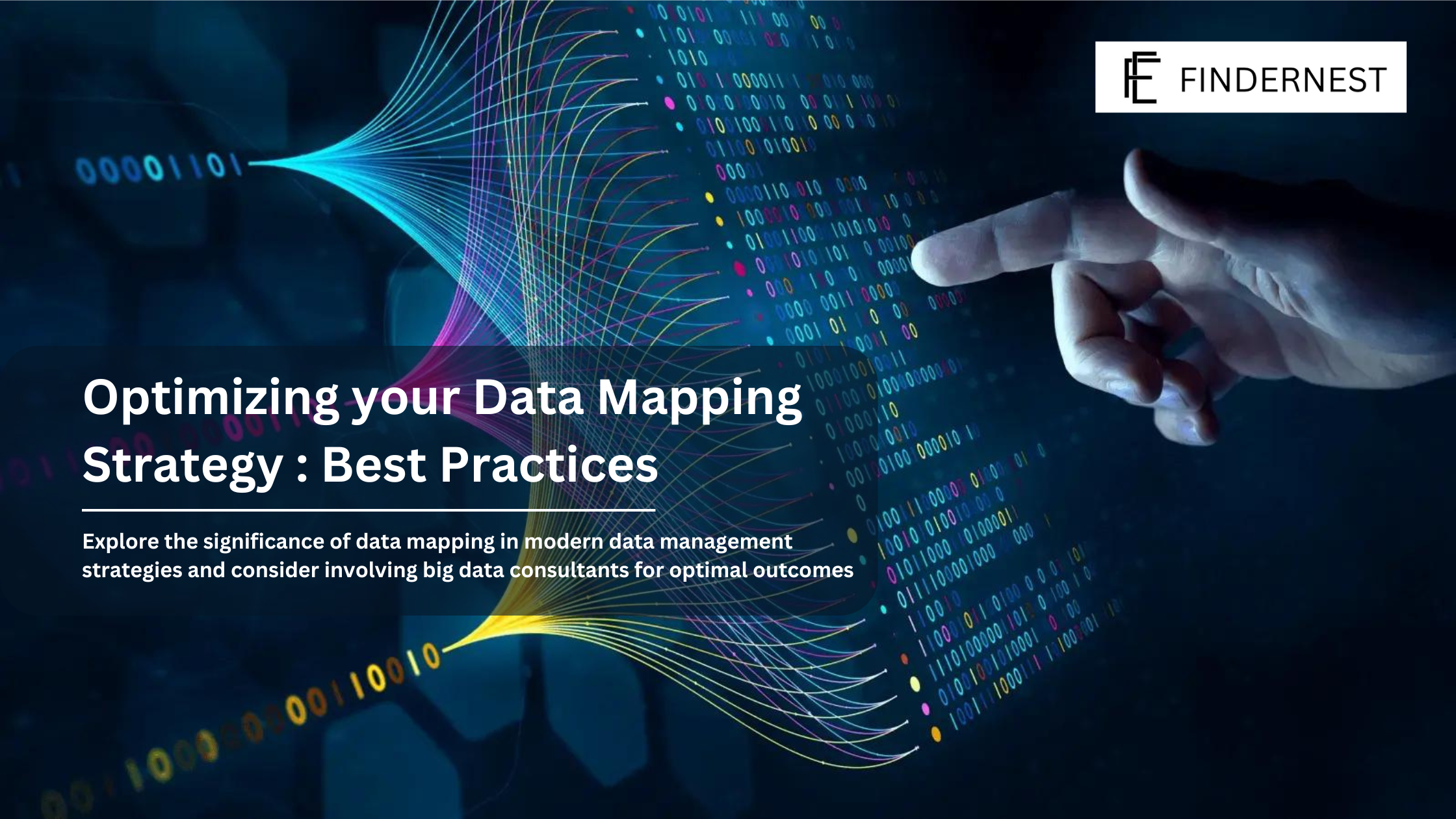Data Engineering | Data Analytics | Data | Data Mapping
Optimizing Your Data Mapping Strategy: Best Practices
Read Time 5 mins | Written by: Praveen Gundala

Uncover the essential best practices for enhancing your data mapping strategy in this comprehensive guide. Data mapping is a crucial component of managing your organizational data flow, playing a key role in various digital projects such as data modernization, software development, integration initiatives, and more. When implementing new business intelligence (BI) tools, data mapping is also instrumental.
This article delves into the definition of data mapping and emphasizes the benefits of engaging big data consultants for your data projects, rather than relying solely on your in-house team.
Part of our data series, this article explores different facets of enterprise data flow management and monitoring. Visit our blog for insights on data masking, data governance, unstructured data, as well as explanations on data warehouse, data lake, and data lakehouse distinctions. Additionally, we provide guidance on preparing data for machine learning algorithms.
Without delay, let’s delve into the intricacies of the data mapping process.
Understanding the fundamentals of data mapping
Data mapping is the essential process of aligning data fields from one source to another, facilitating the seamless connection of information across various databases and data models. This pivotal step in software development, migration, and integration endeavours ensures the accurate transfer and alignment of data between systems, demanding careful attention to avoid potential pitfalls that could compromise project success.
What is the purpose of data mapping?
Data mapping seldom stands alone; it is usually intertwined with the data journey within a broader project. Whenever there is a need to modify an existing data structure or create a new one, data mapping is often an integral part of this transformative process. Data mapping plays a crucial role in a variety of key initiatives, including:
-
Data integration
Involves consolidating data from diverse sources, often a continuous process. For example, data integration tasks can be scheduled daily or triggered by specific events.
-
Data migration
Data migration involves transferring data from one system to another, with the original data source often being decommissioned once the migration is successfully finalized. An illustration of this process includes relocating data from a legacy system to a new system or an archive.
-
Data transformation
This entails transforming data from its current structure to a new format, which may involve data cleansing to remove duplicates and null values. For instance, converting unstructured text data into a structured format like a comma-separated values (CSV) file is a common example of this transformation process.
-
Deploying reporting tools
Certain out-of-the-box reporting tools come with unique terminology and predefined data structures, prompting companies to align their data with the schema of these tools.
-
Custom software development
Every time a new software application is introduced, it comes with a backend database or storage system that requires mapping to existing data sources when integrating it into your system.
In essence, data mapping is indispensable to guarantee the precision, uniformity, and utility of data across diverse business functions.
What specific role does data mapping play in driving the success of the initiatives mentioned above?
Every application within your IT infrastructure generates valuable data, each with its distinct structures and schemas.
Imagine a scenario where a single data element in one structure seamlessly combines elements from another structure. For example, a 'full_name' field in one database could mirror the amalgamation of 'given_name' and 'family_name' fields in a separate database.
Moreover, there are instances where a mathematical computation is necessary to align data fields. For instance, when trying to synchronize the 'expiration_date' field in the target structure with no direct match in the source, you can calculate the 'expiration_date' by adding the 'validity_period' to the 'production_date'
Implementing effective data mapping techniques
To implement effective data mapping techniques, consider the following best practices:
- Clearly define the objectives and requirements of the data mapping process before starting.
- Understand the data structures and schemas of the data sources involved to identify potential mapping challenges and complexities.
- Use standardized data mapping tools or software to streamline the process and ensure consistency.
- Document the data mapping process, including the mapping rules, transformations, and any exceptions or special cases.
- Regularly validate and test the data mapping results to ensure accuracy and identify any issues or discrepancies.
- Involve stakeholders and subject matter experts to gather insights and ensure the mapping aligns with business needs and goals.
- Continuously monitor and update the data mapping as new data sources or changes in existing sources occur.
By implementing these techniques, organizations can optimize their data mapping strategy and improve the overall quality and reliability of their data.
Data mapping steps
If your team opts to handle the data mappings internally, here are five essential steps to navigate you through the data mapping process:
Step 1: Begin by clearly defining the desired outcome and structure of your target schema, envisioning the layout of your ultimate database configuration.
Step 2: Identify the diverse array of data sources at your disposal, ranging from business operating systems to relational databases and data obtained through APIs in varying formats like CSV, JSON, or XLSX. Delve into the intricacies of these datasets, understanding the relationships and connections between their individual fields.
Step 3: Pinpoint specific data entries that necessitate transformation before embarking on the mapping process, ensuring that all necessary changes are accounted for.
Step 4: Establish the transformation rules and mapping logic in a formalized manner, outlining the precise steps required to align and integrate your data effectively.
Step 5: Put your logic to the test by experimenting with a small sample of data, refining and adjusting your approach as needed to achieve optimal results.
Leveraging professional expertise for efficient data mapping
In today's fast-paced and data-driven business landscape, the importance of seeking professional expertise for data mapping cannot be overstated. Without the guidance of experienced data professionals, organizations may find themselves facing a myriad of risks and obstacles that could potentially derail their data mapping initiatives.
Internal staff members who lack experience in data mapping may inadvertently overlook critical aspects or make errors that could compromise the accuracy and efficiency of the process. This is where the expertise of data specialists comes into play. These professionals possess the necessary proficiency and know-how to navigate through mapping complexities, handle data transformations seamlessly, and optimize the entire mapping process for maximum effectiveness.
By enlisting the help of data specialists, organizations not only save time and minimize risks but also elevate the overall quality of their data mapping results. These experts bring a wealth of knowledge and experience to the table, enabling organizations to tackle even the most intricate mapping challenges with confidence and precision.
Collaborating with a reputable data flow management partner like Findernest can further enhance the success of data mapping initiatives. By leveraging the expertise of such partners, organizations can gain access to expert guidance and support throughout the entire data mapping process. This strategic collaboration empowers organizations to navigate the complexities of data mapping with ease, ensuring that their data projects are executed seamlessly and with optimal results.
Bring us your Challenge
Learn how FindErnest is making a difference in the world of business
Praveen Gundala
Praveen Gundala, Founder and Chief Executive Officer of FindErnest, provides value-added information technology and innovative digital solutions that enhance client business performance, accelerate time-to-market, increase productivity, and improve customer service. FindErnest offers end-to-end solutions tailored to clients' specific needs. Our persuasive tone emphasizes our dedication to producing outstanding outcomes and our capacity to use talent and technology to propel business success. I have a strong interest in using cutting-edge technology and creative solutions to fulfill the constantly changing needs of businesses. In order to keep up with the latest developments, I am always looking for ways to improve my knowledge and abilities. Fast-paced work environments are my favorite because they allow me to use my drive and entrepreneurial spirit to produce amazing results. My outstanding leadership and communication abilities enable me to inspire and encourage my team and create a successful culture.

